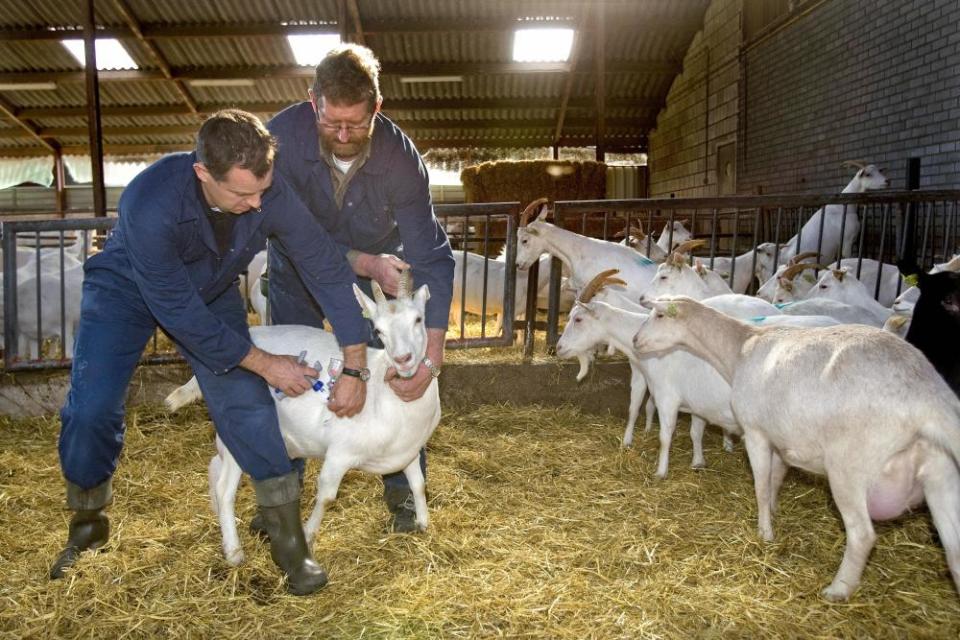'We need answers’: why are people living near Dutch goat farms getting sick?

In early 2008, Jeannette van de Ven began to see a slightly higher rate of miscarriages among the goats on her dairy farm in the south of the Netherlands.
“We sent the samples to the veterinary authority. Nine out of 10 results showed no explanation. Only maybe toxoplasmosis from cats. We had no cats,” she says.
Van de Ven, who keeps a herd of around 1,700 dairy goats in Noord-Brabant, a province densely populated with goat farms, kept sending samples. Finally, in May 2008 an outbreak of the respiratory infection Q fever was confirmed. It infects livestock including goats, sheep and cattle, and is found in placenta, amniotic fluid, urine, faeces and milk.
Watch: What is long COVID?
The disease turned into a nightmare for the Netherlands after thousands of people also became infected during the outbreak, which lasted from 2007 to 2010. The Dutch government culled more than 50,000 dairy goats on 55 farms in an effort to stop the spread of the disease.
About half of the humans infected ended up developing complications, such as heart failure, and 95 people died.
Related: Covid and farm animals: nine pandemics that changed the world
A decade on, another zoonotic disease risk is worrying Dutch goat farmers and scientists, as studies by public health and veterinary experts have linked human cases of pneumonia to goat farms.
People living near goat farms have a 20% to 55% higher risk of developing pneumonia, says Dick Heederik, a human-animal disease risk expert at the University of Utrecht. The closer to the goat farm, the higher the risk, he adds: “Analysis indicates that the increased risk is seen at a radius of 1–1.5km.”

The effects vary, with some people having no symptoms and others developing fever, chills, fatigue and muscle pain.
Having a second zoonotic disease risk linked to goats is, says farmers, frustrating, confusing and stressful. “The money is still good for milk, but there is more stress around permits and for the public the news in the papers is negative about goats,” said Egbert ter Veen, who has about 50 dairy goats on his farm.
The Q fever outbreak followed a period of rapid growth in goat dairying in the Netherlands and its aftermath heightened tensions around zoonotic disease threats, especially in the south of the country where the highest numbers of goat farms and infection rates were found.
There has also been an intense debate over the size and regulation of the livestock sector in the country, with calls for a halving of livestock numbers to tackle the environmental impact.
By the time the Q fever outbreak was contained in 2010, more than 4,000 human cases had been reported and an estimated 50,000 people had been infected, says Johanna van der Giessen, a veterinary microbiologist and zoonotic disease specialist at the Dutch National Institute for Public Health and the Environment.
Watch: Should I pay off debt or save money during the coronavirus pandemic?
Related: Could a deadly pig virus transform Germany’s fixation on 'cheap meat'?
Since the Q fever cull, goat farmers have been slowly restocking – national goat milk production has boomed over the past two decades with export markets including cheese to Germany and goat milk-based infant formula to China. The cull, and other measures including an annual goat vaccination programme, mean Q fever is no longer a risk, says Van der Giessen.
But the pneumonia findings, which first emerged in 2013, led to restrictions on the sector starting in 2017, even as demand for goat milk continued to rise.
In Noord-Brabant, and several other provinces, expansion has effectively been frozen until the links to higher pneumonia rates can be identified and managed, says Van de Ven.
In general, “a larger density of animals per farm may contribute to infectious diseases”, says Lidwien Smit, who is based at the University of Utrecht’s veterinary faculty and part of the team that first discovered higher pneumonia rates in people living near goat farms. Smit stressed, however, that in relation to goat farms, there is as yet no “clear link between farm size and disease incidence around those farms.”
Our hypothesis is that this could be a new zoonotic disease but we really don't know
Johanna van der Giessen, scientist
Dutch researchers are continuing to investigate the pneumonia link. Jos Tolboom, who chairs the goat department at Dutch farmer union the Netherlands Agricultural and Horticultural Association (LTO), argues that because there is no definite causal link yet between the goats and higher pneumonia risk, other factors could be at play. “It could be that since the Q fever outbreak people living near goat farms are more quick to go to the doctor,” he says.
For Van der Giessen, a zoonotic cause is plausible. That is partly because a similar pneumonia risk for poultry farms has now been linked to a dust issue. This is not the case for goat farms.
“We are now looking for a cause and since there is no Q fever and there is not so much evidence of it being related to the fine dust particles, our hypothesis is that this could be a new zoonotic disease, but we really don’t know,” she says.
Without an answer for now, Tolboom fears the goat farm restrictions will continue and “people may start doubting if [livestock farming] is worth it.”
“We will probably hit the current expansion limits this year. A few years ago, the growth in the dairy goat herd was about 15% a year. Now it is about 3%. I can’t see those limits changing for the next year or two until the questions around pneumonia risks are resolved.”
Sign up for the Animals farmed monthly update to get a roundup of the best farming and food stories across the world and keep up with our investigations. You can send us your stories and thoughts at animalsfarmed@theguardian.com

